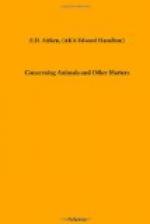[Illustration: “TEAR OUT THE HOUSE LIKE THE DOGS WUZ ATTER HIM.”]
But when he “tear out the house like the dogs wuz atter him,” then they point straight back. He was made to be eaten, and he knows it. So it is with the whole tribe of deer, and even with the horse, pampered and cared for and unacquainted with danger; his ears are a weathercock registering the drift of all his petty hopes and fears. I see the left ear go forward and prepare for a desperate shy at that wheelbarrow. He knows a wheelbarrow familiarly—there is one in his stall all day—but I am taking him a road he does not want to go, and so the hypocrite is going to pretend that barrow is of a dangerous sort. I prepare to apply a counter-irritant: he sees it with the corner of his eye, and both ears turn back like a tuning-fork.
The size and quality of the ear serve to show how far the owner depends on it. You will never begin to understand Nature until you see clearly that every life is dominated by two supreme anxieties which push aside all other concerns—viz., to eat, and not to be eaten. The one is uppermost in those that pursue, and the other in those that flee. Now if the pursuer fails he loses a dinner, but if the fugitive fails he loses his life, from which it follows that the very best sort of ears will be found among those beasts that do not ravage but run.
But there is another matter to be taken into account. The ears are not the whole of the beast’s outfit. It has eyes, and it has a nose. Which of the three it most relies on depends upon the manner of its life. A bird lives in trees or the air, looking down at the prowling cat or up at the hawk hovering in the clear sky; so it does not keep ears, and its nose is of no account. But what four-footed thing can see like a bird? The squirrel also lives in the trees, and its ears are frivolously decorated with tufts of hair. You will not find many beasts that can afford to prostitute their ears to ornamental purposes. The only other beast that I can think of at this moment which has tufted ears is the lynx. Now the lynx is a tree cat, and there is proverbial wisdom in the saying “Eyes like a lynx.”




